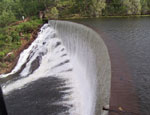 The salinity distribution within coastal waterways reflects the relative influx of fresh water supplied by rivers, and marine water supplied by exchange with the ocean. Large incursions of freshwater can severely depress normal salinity levels in estuaries, leading to habitat loss, a decrease in biodiversity, fish kills and a change in animal and plant physiology.
The salinity distribution within coastal waterways reflects the relative influx of fresh water supplied by rivers, and marine water supplied by exchange with the ocean. Large incursions of freshwater can severely depress normal salinity levels in estuaries, leading to habitat loss, a decrease in biodiversity, fish kills and a change in animal and plant physiology.
Residence times/flushing rates/dilution efficiency are natural mediating factors which influence the impact of excess freshwater on the ecosystem.
Potential indicators
There are a number of causes and symptoms related to this stressor. The following indicators are recommended for the stressor ‘Excess freshwater’:
Pressure indicators
Indicators of excess freshwater sources:
Indicators of direct pressure:
- Total point source freshwater load entering the estuary.
Vulnerability indicators
Condition indicators
Physical-chemical condition indicators:
Biological condition indicators:
- None
| Possible causes | Possible symptoms |
The actions/events/situations that might induce this stress:
|
The actions/events/situations that might arise from a change to the stressor:
|
Fact sheets on background science and economics
Other information on excess freshwater
Australia
Estuary Condition Assessments. Choose your estuary from the list. If available, you can download an estuary condition assessment for the estuary, which provides pathogen data where available.
Queensland
Brisbane River Automated Monitoring. Here you can view the latest water quality for three locations in the Brisbane River. Daily salinity data can be viewed on graphs.
South Australia
The Surface Water Archive contains rainfall, water level, streamflow, and salinity data collected from a network of surfacewater monitoring sites located throughout South Australia.
Models
Australia
Dynamic Reservoir Simulation Model (DYRESM) is a one-dimensional hydrodynamics model for predicting the vertical distribution of temperature, salinity and density in lakes and reservoirs.
Catchment Modelling Toolkit. The Catchment Modelling Toolkit is a repository of software and supporting documentation intended to improve the efficiency and standard of catchment modelling.
International
USGS Hydrologic and Geochemical Models are widely used to predict responses of hydrologic systems to changing stresses, such as increases in precipitation or ground-water pumping rates, as well as to predict the fate and movement of solutes and contaminants in water.


